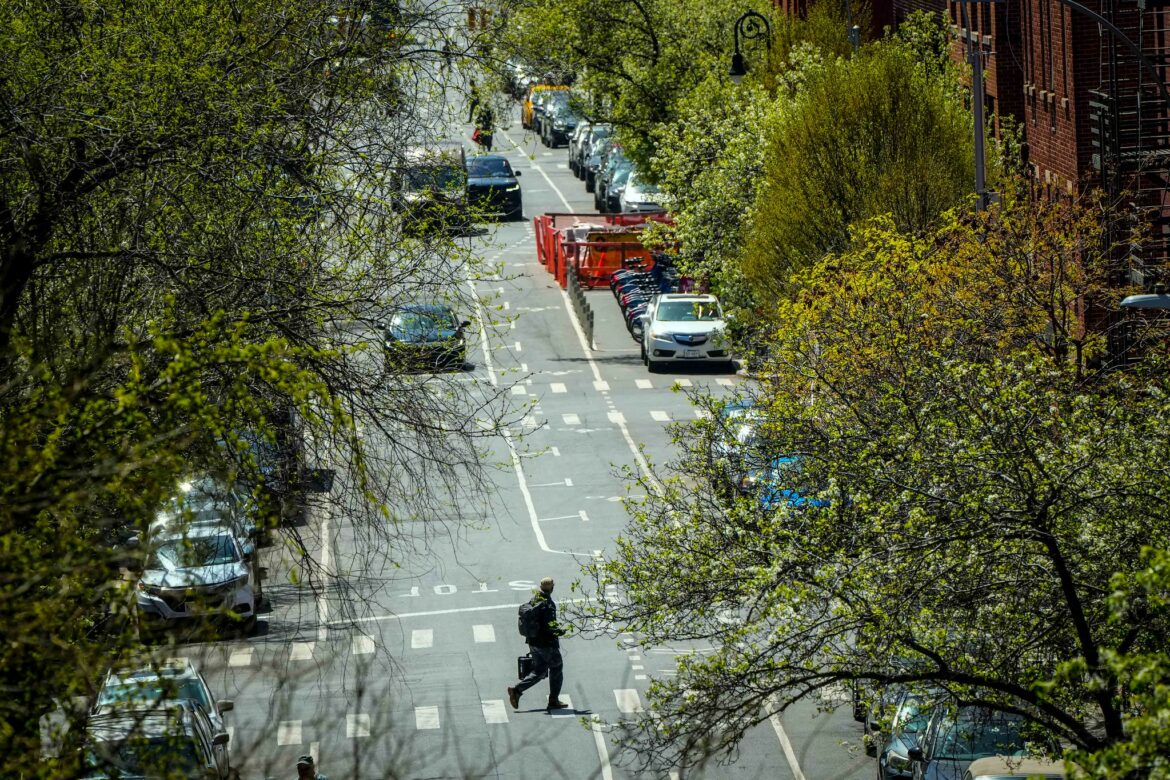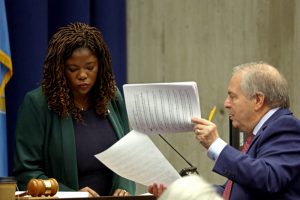
Opinion: Heat Waves Show Why NYC Needs More Trees
“How do we keep people safe from extreme heat in an age of ever-increasing temperatures? One solution may be right in front of us: we need to plant more trees in the most heat-vulnerable areas and take better care of the ones we’ve got.”
Michael Appleton/Mayoral Photography Office
Trees along Greenwich Street in Manhattan.
CityViews are readers’ opinions, not those of City Limits. Add your voice today!
The summer of 2024 has seen the hottest days the world has ever seen, and much of New York City swelter through several heat waves.
Heat waves result in the most deaths compared to any weather event. Extreme heat can cause or intensify a wide range of health problems, like heart disease, respiratory illness, mental illness, and heat sickness—problems that are only likely to worsen in the future as climate change makes these events more likely.
This fact is alarming for all of us but particularly for those most vulnerable to extreme heat—babies, young children, older adults, people with low income, people who are already sick, and people who are a minoritized race/ethnicity.
In New York City, the neighborhoods that are most vulnerable to extreme heat are generally hotter and have more Black residents and low-income residents, and less green space and air conditioning access—all made worse by the urban heat island effect, where heat is trapped in paved areas and buildings.
Although we know who is most vulnerable to extreme heat, our public health systems have been limited to advisories to their impact. So, how do we intervene? How do we keep people safe from extreme heat in an age of ever-increasing temperatures?
One solution may be right in front of us: we need to plant more trees in the most heat-vulnerable areas and take better care of the ones we’ve got. Recent reports on extreme heat reinforce the relationship between green space and heat: when there is more green space, heat decreases. In one example in the summer of 2021, the surface of a tree-lined sidewalk in Central Park West was 31 degrees cooler than a treeless lot in East Harlem.
Trees provide cooling in two ways: shade and evapotranspiration (a.k.a tree sweat). They also are just great to have around—studies have shown that trees are also associated with better physical and mental health outcomes.
For these reasons and more, cities around the U.S., including New York City, have begun to prioritize expanding and maintaining the urban forest—and they should continue to do so with a focus on extreme heat.
The current tree canopy distribution in New York City is unequal. Linking the realities of environmental injustice and public health will help us build better plans for our urban trees—best done through community-based decision-making and prioritizing the experiences of those who will have to live with the trees.
Combating heat with trees also means caring for the ones we already have. Planting new trees can feel glamorous, picture-worthy, and provide a few hours of healthy fun. But these trees need care to survive, and older trees are also essential for cooling, but they also need consistent care and well-funded support for their maintenance. Those mature trees with expansive canopies play an outsized role cooling our city during heat waves.
As the climate changes, we also want to ensure that the trees we plant today can survive and mature in the climates of tomorrow. Where tree species thrive is changing as temperatures warm.
Trees alone are not the answer to extreme heat, but they are a key part of a long-term solution. Other vital efforts to keep people safe in the immediate future, like the recent call for FEMA to declare extreme heat a disaster, are also important to ensuring that people have sufficient access to cooling centers, medical care, water, electricity, and other crucial needs during heat waves. Implementing the Extreme Heat Policy Agenda and a national framework for urban forestry would also be great steps forward.
We need improved emergency preparedness, communications, and resources for affected communities and we also need more equitable landscapes to help all New Yorkers better weather extreme heat. To that end, as New York City embarks on developing its first legally required citywide urban forest plan, we have a unique global leadership opportunity to advance public health and tackle extreme heat by working in partnership with communities to improve our cityscape with more and better protected and cared for trees and canopy.
These actions will set the stage for our health, and the health of future generations. We hope they can reap the benefits of the seeds we sow today.
Arnab K. Ghosh is an assistant professor of medicine at Weill Cornell Medicine and the the 2024 NIH Climate and Health Scholar. Olivia J. Keenan is a climate and health researcher at Weill Cornell Medicine. Emily Nobel Maxwell is founder and principal of Nobel Cause Consulting, and former New York Cities director of The Nature Conservancy.
The post Opinion: Heat Waves Show Why NYC Needs More Trees appeared first on City Limits.

